Corset controversy
The corset controversy concerns supporters' and detractors' arguments for and against wearing a corset. The controversy was contemporary with the time that corsets were popular in society. Corsets, variously called a pair of bodys or stays, were worn by European women from the late 16th century onward, changing their form as fashions changed. In spite of radical change to fashion geographically and temporally, the corset or some derivative beneath an outer gown would shape the body or provide structure.
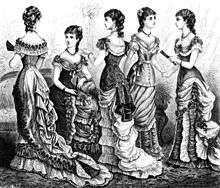
There were brief periods in which corsetry was not part of mainstream fashion. In the 1790s, there was an abrupt change to fashion as the Empire silhouette became fashionable. During the following Regency era the highly supportive corsets of the early Georgian era were dismissed in favor of short garments worn primarily to support the breast and leave the waist and hips in their natural shape.[1]
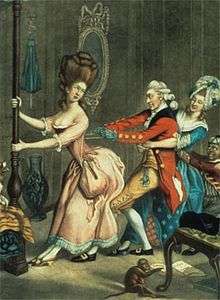
Beginning in the mid-1820s, women's fashion returned to the full skirts of the prior century. In a repudiation of the Empire silhouette, the waist became the central focus of female dress. The corset assumed the dominant role it would hold for the rest of the 19th century. Designed to emphasize the waist through minimizing it, corsets would constrict the waistline in order to achieve a slender silhouette.[2] Doctors and much of the press deplored the garment in spite of continued use.[3]
Criticism
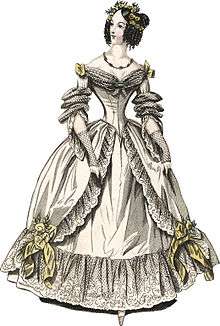
Wearing corsets has been subject to criticism since the era of tight lacing during the prior century. Jean-Jacques Rousseau denounced the practice in The Lancet[4] while cartoons of the period satirized the practice. However, by the 19th century, women were writing letters to publications expressing their views directly and articulately. The one-sided denunciation of the past turned into a dialogue. Women made their voices heard, sharing their experiences and their opinions, some in favor of the corset and even tight lacing, and some in disfavor of the restrictive garment. Newspapers and popular journals became the media for the exchange of hundreds of letters and articles concerning the corset.
Known as the "corset controversy" or simply the "corset question", the controversy spilled over multiple publications, countries and decades. Of particular concern was the issue of tight lacing. The flow of articles and letters waxed and waned over time, reaching a crescendo in the late 1860s, which may be taken to be the peak of the frenzy. However, the issue surfaced long before and continued long afterward. Throughout this period, advertisements in the same publications promoted the sale of corsets with enthusiasm.[5]
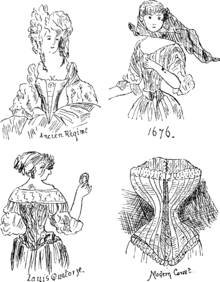
In the United Kingdom, publications in which the controversy raged included The Times, Lancet, Queen, The Scotsman, Ladies Treasury, The Englishwomen's Domestic Magazine, and All the Year Round. In the United States, the Chicago Tribune commented that English journalists discussed both sides of the controversy "with very great fervor and very little common sense," though it published its own contributions.[6] Other American newspapers and periodicals also participated, including The New York Times, The Washington Post, The Boston Globe, the Hartford Daily Courant, the North American Review, and The Saint Paul Daily Globe. Other parts of the English-speaking world joined from time to time, reprinting articles from England and America, as well as contributing their own. Even provincial newspapers such as the Amador Ledger of California, the Hobart Town Courier, the Otago Witness, and the Timaru Herald of New Zealand had their say.
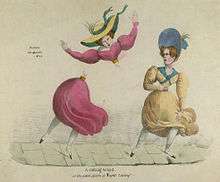
The line between wearing corsets in general and tight lacing in particular was never drawn precisely. Many detractors denounced both, obviating the distinction, while many advocates endorsed both. Additionally, many women who wore corsets denied that they tight-laced, adding confusion to the controversy. The West Coast Times wrote that "consequences of tight lacing are universally admitted," yet ladies' denial persisted. They preferred to claim that their small waist was "a gift of Nature" and that they wear a corset for "comfortable, if not necessary support." [7]
Corsets and fashion
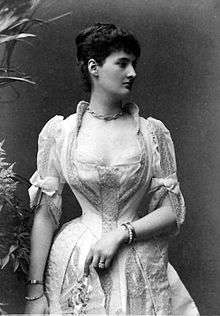
The dominant aesthetic of the mid-nineteenth century called for full skirts. Prior to the common wearing of the crinoline, several petticoats would be worn in order to provide this fullness. A corset, used to constrict the waist and create slenderness, could also accentuate a full skirt through comparison.
The Saint Paul Daily Globe wrote of corsetry:[8]
There is not a single fashionable woman who does not wear a corset. Some of the slender young debutantes affect the picturesque princess bodice, with the whalebones inserted in every seam.
There were countless denunciations. Fashions that required a tiny waist were deemed oppressive. One such appeared in the Chicago Tribune[9]
THE SLAVES OF FASHION, through Long Centuries Women Have Obeyed Her Whims
It is difficult to imagine a slavery more senseless, cruel or far-reaching in its injurious consequences than that imposed by fashion on civilized womanhood during the last generation. ... the tight lacing required by the wasp waist has produced generations of invalids and bequeathed to posterity suffering that will not vanish for many decades. ... And in order to look stylish, thousands of women wear dress waist so tight that no free movement of the upper body is possible; indeed in numbers of instances, ladies are compelled to put their bonnets on before attempting the painful ordeal of getting into glove-fitting dress waists.
Yet some women professed to enjoy the practice. A letter to the Boston Globe reads[10]
I myself have never felt any ill effects from nearly 30 years of the most severe tight lacing, nor have I yet found any authentic case of real harm being done by stays, even when laced to the utmost degree of tightness, both day and night.
People who write against the practice of tight lacing are either those who have never been laced and have never take the trouble to inquire into the pros and cons of the subject, or those who have, perhaps been once lace up very tightly in badly made, ill-fitting stays with the settled determination of finding them most awful instruments of torture.
Those who have been systematically laced up in proper stays from their childhood are the only ones who are capable of forming a right judgment on this subject and I hope you will allow tight lacers the opportunity of defending themselves against the enemies of trim little waist.
A reader wrote to The Toronto Daily Mail insisting that only those who had experienced tight lacing could understand its pleasures[11]
I am glad that the subject of figure training is under consideration, because so much nonsense is talked on the subject of tight-lacing. The fun of it is, all the condemnation comes from those who don't wear stays, either from men or from women with hobbies and without waists. All who have tried tight-lacing speak approvingly of it. I would not give up my well-made, tight fitting stays for anything. The sensation of being laced in tight is an enjoyable one that only those who have experienced it can understand. I have been in corsets ever since I was eight years of age, and I am now past my teens, and though I am five feet four inches tall and broad in the shoulders, I only measure nineteen inches, and I am in capital health.
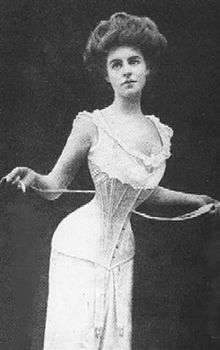
The editor of the "Women's Chats" section of the West Australian advocated "tight lacing in moderation"[12]
I will always assert that corsets improve an indifferent figure and add to the beauty of a good one, and I will even admit that for a woman who aspires to look fashionable something might be said for tight lacing in moderation. The phrases sound rather contradictory, but readers of my own sex will know what I mean – a corset tight enough to grasp the figure, but not so tight as nearly to cut it in two.
A corsetiere described how women might attain the desired waist size[13]
In our business, we constantly find women who want to have the waist made smaller and who are willing to endure anything in the world except hanging to get a little waist. ... We measure the corset, pulling the measurements snug. And we tell the woman to wear it as tightly as she can comfortably do. Then we suggest a series of corsets, each a little smaller than the last, thus making the transition a slow and easy one from a big waist to a little one.
We frequently have customers who want to wear a corset day and night in the extreme eagerness to get thin. ... We have made this woman two corsets, one for day wear and one for night wear. The day corset is a nineteen inch. ... As soon as the waist has been reduced, and it is coming down rapidly, we will make two more corsets. The new ones will measure seventeen for day wear and eighteen inches for night wear. And in a short time we hope to present the woman with a pair of sixteen inch corsets to fit her exactly.
Medical criticism
Doctors railed against the practice as decidedly harmful. Some women replied that tight lacing was actually beneficial as well as enjoyable, while other women responded to the critiques with wholehearted agreement, sometimes citing their own negative experiences. The following exchange, which took place during ten days in 1869 in the pages of The Times of London, gives a flavor of the discourse that volleyed back and forth for decades. The exchange was initiated by a note in the British medical journal, The Lancet,[3] which was reprinted in The Times of London.
Our old friend, tight-lacing, has again made his appearance. ... The folly is one which was formerly to be found mainly in the drawing-room, but now it also fills our streets. It is lamentable to observe at every turn a woman, young or old, who moves forward in a stooping position, unable even to hold herself upright in consequence of the constraint upon the muscles of the back. ... as medical practitioners, we see its effects every day in the train of nervous and dyspeptic symptoms by this it is constantly indicated, and in the still more grave internal mischief of permanent character which is often caused by it. Until some little physiological knowledge is made a part of female education, and is considered an "accomplishment", we suppose it is of little use to protest against the cruel injury to health which women thus inflict upon themselves.
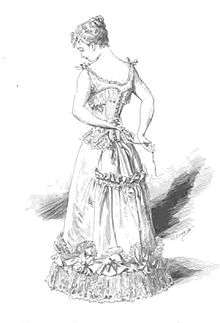
A reader signing herself "Not a Girl of the Period" wrote a letter to The Times in reply[14]
Sir, – As the paragraph with the above heading, copied in The Times from the Lancet a few days ago, has naturally excited some discussion among those affected by it, I request to say a few words in our defense. The writer in the Lancet says he sees ladies stooping in consequences of being tight-laced. As any person of experience knows that wearing tight stays of proper construction, and stiff enough in front, produces exactly the contrary effect. Those whom he sees stooping have either acquired the habit during the late fashion of neglecting the figure, or are led into it by wearing the stays with weak steels in front, for which we are indebted to the doctors ...
He may learn from Fairholt's Costumes and other books, that in spite of the denunciations of doctors of medicine and theology, this fashion has flourished throughout Europe for a thousand years at least and no means among our sex alone. And if he will, for once, consult instead of advising those who have had real experience of it, he will learn that when practiced judiciously it is not only harmless, but often beneficial to health, and extremely pleasant.
A reader, signing herself, Anti-Slavery countered[14]
... feminine curiosity compels me to ask what sort of flesh and blood, body and bones are possessed by "not a Girl of the Period" to enable her to find tight-lacing "extremely pleasant" ... Tight-lacing, or an approach to it, is as extremely unpleasant as it is unnecessary for either health or elegance. It is practiced because its victims suppose it improves their appearance, and because they can bear it with that female fortitude which enables us to endure so much. ... I have not worn stays or any substitute for them since my school days, and many friends who have paid me the complement of wishing to imitate my carriage have left them off too, and have never returned to them, finding that their figures suffered no more than mine from the freedom which is too delightful to give up.
The Lancet felt compelled to reply as well, expanding on its medical arguments[14]
The writer of a letter to 'The Times', who signs herself "not a Girl of the Period", takes up the cudgels on behalf of the tight lacers, and impugns the accuracy of our options that the practice is as injurious to the health as its effects are monstrous to the eye. ... If a lady encases herself in a stiff pair of stays, and laces them tightly, the lungs would be quite unprovided with air, and she would speedily die but for the action of the diaphragm. By this she is saved, but her safety is purchased at a ruinous expense.
And we do not hesitate to say that to the practice of tight lacing is due a very large number of distressing female ailments, over and beyond those derangements of digestion and circulation to which we have already referenced in our former article. The writer in The Times refers us to Fairholt's Costumes, for proof that, in spite of denunciation, the fashion has flourished throughout Europe for a thousand years at least, and her inference is evident that the continuance of the practice under these circumstances proved it innocuous – a style of argument by which, we need scarcely remark, the harmlessness of theft, murder, drunkenness, and a few other "fashions" might equally well be substantiated. —The Lancet
Other readers wrote to extol the virtues of tight lacing[14]
... though few ladies may be able to attain the coveted size of "16 inches that may be spanned", such is the flexibility of the female frame that with properly fitted stays – not the flimsy ready-made article generally sold – most ladies may, without discomfort or injury, attain a smallness of waist that would delight both themselves and their friends.
The distinguished anatomist William Henry Flower in 1881 published a book [15] demonstrating by text and illustrations the deformities caused to female anatomy by corsets. [16] [17] This did not prevent his wife and four daughters from wearing them.
Mothers and daughters
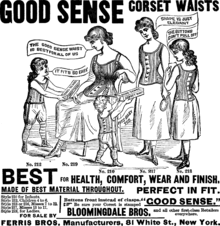
It was expected that women would wear corsets and it was part of a mother's duty to her female offspring to have them wear the garment.[18] Just how and when might depend on the mother, the daughter, the place, and the time. However, some things were much the same everywhere. Three examples, one from the American frontier of 1880, another from London in 1907, and a third from 1883 are variations on the theme.
Laura Ingalls Wilder was an American author who wrote a series of children's books based on her childhood in a pioneer family. Little Town on the Prairie is set in 1880 in South Dakota in an area recently settled. Despite being on the frontier, the women and, in particular the girls, were expected to behave according to the norms of the times. Its 1941 publication date takes it out of the "discussion" period, but as it was written as a children's book for girls, its account is unlikely to be spurious or a fantasy, so it serves as a reliable testament of some of the more curious practices such as sleeping in corsets.
The family had four daughters, Mary, Laura, Carrie, and Grace, the youngest. Mary, the eldest, tries on a dress that is found not to fit until her corset is laced more tightly, leading to the following exchange:[19]
"I'm glad I don't have to wear corsets yet," said Carrie.
"Be glad while you can be," said Laura. "You'll have to wear them pretty soon." Her corsets were a sad affliction to her, from the time she put them on in the morning until she took them off at night. But when girls pinned up their hair and wore skirts down to their shoe tops, they must wear corsets.
"You should wear them at night," Ma said. Mary did, but Laura could not bear at night the torment of the steels that would not let her draw a deep breath. Always before she could get to sleep, she had to take off her corsets.
"What your figure will be, goodness knows," Ma warned her. "When I was married, your Pa could span my waist with his two hands."
Readers wrote to The Gentlewoman describing personal experiences with tight lacing. For example,[20]
My cousin wrote to you this week, but forgot to ask your opinion of this régime for a family, of girls – the eldest nineteen, the youngest thirteen. She has a great desire for them all to have slim, pretty figures, ... As soon as they get up they are closely laced in beautifully fitting stays that fit them like gloves, and for no consideration are they ever laced more loosely. At about 4:30 the three elder girls of 17, 18, and 19 have to go upstairs to have their corsets tightened for the evening, which means that they come down in about half an hour with the trimmest and tiniest of waists confined in evening corsets laced with no sparing hand. All three have quite taken to lacing, and do not object to sleeping in well-laced corsets about an inch larger than their day ones.[20]
In publishing this and other letters, the editor of The Gentlewoman admonished the writers:
Those women who have not been guilty of the folly and iniquity of tight-lacing, or being free from it personally, have given no thought to the subject, will stand against at the widespread wickedness that is practiced by girls and women who are addicted to this pernicious habit. I have been led to take this step because the hundreds of letters which have reached me from the young asking advice how to achieve a narrow waist, and from older ones giving their experience and describing their sufferings, all proved, what I had not previously imagined, that the tight-lacing habit had become a sin and a scandal.[20]
There was no shortage of others who condemned mothers and daughters who participated in the practice. For example:[21]
What is to be said for the sinful folly (the mania is apparently not confined to the young) of the mother who put her child into corsets at six years old, or the young lady who "enjoys the feeling of tight lacing so much," and never lets her waist exceed 17 inches or 153⁄4 if she has no breakfast? We are not surprised to hear that she cannot walk. Are there really such foolish relatives as the one who insisted on a young woman reducing her waist to 17 inches saying "No man will marry a girl unless she looks smart." These unfortunate victims of fashion sleep in their corsets, and know no release night or day from the agony of tight ligaments pressing gradually on soft and growing bones.
Childhood

In some cases, mothers started their daughters wearing corsets in early childhood. The New York Times described the practice in its Fashion section.[22]
From the time an infant wears dresses, a kind of broad belt is used, with shoulder pieces. To this, the child's undergarments are buttoned. Little girls wear these until they are about 7 years of age. From this time, the belt has rather more shape, and the back part is supported on both sides by a whalebone or a very soft steel spring. From the age of 10 to 12 years, another bone is added in the back. Corsets for young ladies have busks, narrow whalebones, and very soft steel springs. Ladies' corsets of satin or other material have jointed busks, and are drawn in over the hips, making the front of the corsets very long.
An account from a young lady reads:[20]
A friend of mine has a wonderfully slender figure, which she says is the result of her mother putting a flannel band round her, when she was only a year old, to mould her soft bones. At six she wore a corded corset with whalebones, and at thirteen her mother had her tightly laced, making her waist only fifteen inches.
Mothers wrote letters describing their version of the practice. The following, published in the English periodical Queen,[23] is typical.
... that the formation of the waist is not begun early enough. The consequence of this is, that the waist has to be compressed into a slender shape after it has been allowed to swell, and the stays are therefore made so as to allow of being laced tighter and tighter.
Now I am persuaded that much inconvenience is caused by this practice, which might be entirely avoided by the following simple plan, which I have myself tried with my own daughters, and have found to answer admirably. At the age of seven I had them fitted with stays without much bone and a flexible busk, and these were made to meet from top to bottom when laced, and so as not to exercise the least pressure round the chest and beneath the waist, and only a very slight pressure at the waist, just enough to show off the figure and give it a roundness. To prevent the stays from slipping, easy shoulder-straps were added. In front, extending from the top more than half way to the waist, were two sets of lace-holes, by which the stays could be enlarged round the upper part.
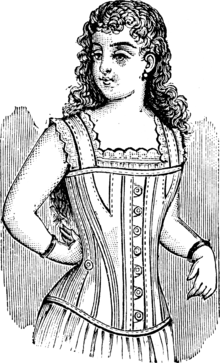
As my daughters grew, these permitted of my always preventing any undue pressure, but I always laced the stays so as to meet behind. When new ones were required they were made exactly the same size at the waist, but as large round the upper part as the gradual enlargement had made the former pair. They were also of course made a little longer, and the position of the shoulder-straps slightly altered; by these means their figures were directed, instead of forced, into a slender shape; no inconvenience was felt, and my daughters, I am happy to say, are straight, and enjoy perfect health, while the waist of the eldest is eighteen inches, and that of the youngest seventeen. I am convinced that my plan is the most reasonable one that can be adopted.
By this means 'tight-lacing' will be abolished, for no tight-lacing or compression is required, and the child, being accustomed to the stays from an early age, does not experience any of the inconveniences which are sometimes felt by those who do not adopt them till twelve or fourteen.
Another letter, in the Boston Globe,[24] is similar:
...I know many mothers who are not only enthusiastic lacers themselves, but are very strict in employing this article of dress in the foundation of their children’s figures. Each of my own daughters – I have four – on her seventh birthday was provided with a snugly-fitting pair of corsets, which she wore from that time out, by night as well as by day, unless in case of decided illness. As the child grew, more bones were added, and the chest and hip measure was increased, but no alteration was made in the waist, and no expansion being allowed during the hours of sleep, its tenuity was retained and there was no necessity of resorting to tight-lacing, which becomes requisite where corsets are not worn until the figure has grown large. It goes without saying that I wear corsets myself, and though I have left youth far behind I still have a figure that provokes admiration ...
Teenage years
Mothers typically put their daughters into serious corsets in their teens or sometimes in the pre-teens. Some were uncertain as to when and how to begin tight lacing. They sought advice in their local newspapers, giving rise to heated discussions. One such exchange took place in the pages of the Toronto Daily Mail, from April to June 1883, in the Saturday section, "Women's Kingdom".
A reader signing herself, "Corset", inquired:[25]
SIR, — I read with great pleasure the article about “Small Waists” in “Woman's Kingdom.” Now, do you think that a girl can be laced tightly without injury? I have two daughters (9 and 12) whom I have never allowed to wear stays, for fear of injuring their constitutions; but they are growing up such clumsy girls that I am quite ashamed of them. Now, perhaps some of your correspondents who are mothers and have brought up daughters will give me advice. I would like to know how many inches I could reduce their waists, and whether it would be better to make this reduction all at once, or by degrees?
The next Saturday, "Staylace" offered her experience:[25]
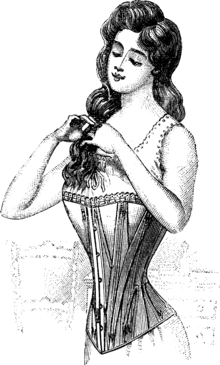
MADAM, — I think I can give some information to "Corset" that will be useful. Nearly a year ago a niece of mine visited me from the country to have the finishing touches put on her education. I was greatly shocked by her appearance. She was fifteen years of age, and had evidently “run wild”. She had never worn corsets, and her figure was very clumsy, her waist actually measuring 25 inches. I had at once a pair of heavily-boned stays made, in which I laced her down to 22 inches. I made her wear the stays by night as well as by day, so that the figure might not expand during the seven or eight hours of sleep. At the end of the month, when the figure became accustomed to the tightness, I had another pair made much smaller round the waist, but quite easy over the hips and chest. In these I reduced her half an inch a month until I brought her waist down to eighteen inches, which I think is small enough.
A few weeks later, "Staylace" submitted excerpts from her niece's diary from the prior year.[25]
June 5. — Yesterday aunt told me she was going to make me wear stays. Didn't like the idea, I have never worn even a tight-fitting dress. Aunt measured my waist and said I was “horrid clumsy.” She then laced me into a pair of stays. I shall never forget the sensation. I felt as if I was all crushed in. I could not bend, but had to sit up as stiff as a pole, and how my back ached! I longed for bed time, but that was no good. My aunt would not take them off, though I begged her to. What a night! I couldn't sleep. I tossed about, and every moment the pain seemed to increase.
June 9. — My stays hurt me worse than ever last night. I cut the laces. What a jolly night's sleep I had, but I caught it this morning. As soon as my aunt laced me up she punished me severely. I guess I'll think twice before cutting the laces again.
July 7. — I had a smaller pair of stays put on yesterday. They hurt me horribly at night. I cut the laces. My aunt again punished me, this time very severely. She says if I again offend she will make me remember. I guess I'll remember as it is.
April 10. — When I think of what I suffered with my stays, it seems very strange that they don't hurt me now. My waist is only 18 inches, and feels more comfortable than when I was squeezed in only a couple of inches. In fact, I think I enjoy the feeling of tightness. I know when I take off my stays to wash, I don't feel comfortable till I get them on again. And then I do guess my figure is sweet. Why, half the girls I know look like old dowdies. I guess my aunt was right, though I did think she was too horrid cruel.
Girls would seek relief from their stays at night and mothers would seek to prevent it. One reader, signing herself "Mother", wrote[25]
I beg to inform one of your correspondents that I have put my girls in stays, and have reduced their waist measure three inches. They still complain of pain from the tightness, and I have a good deal of trouble with them. During the day I can prevent them removing their stays, but at night after leaving them they often take them off. Has any other mother been troubled with her girls in this way, and if so, what did she do to prevent it? I am determined, now that I have commenced, that my girls shall have good figures.
"Kingston" offered her remedy:[25]
I have a very simple plan to prevent my children cutting their laces at night when they are first put in tight stays, to obtain a temporary relief from the pain which is undoubtedly severe at first. When one of my girls disobeys me by removing her stays, I adopt this plan: — After retiring I fasten her wrists together with a silk handkerchief. This keeps her hands out of mischief, and she soon gets accustomed to the stays.
"Common Sense" offered her own alternative:[25]
I positively smiled at the plans suggested to prevent girls under training removing their stays, such as whipping them or tying up their hands. Mothers, listen to my plan. I get a small chain and a little padlock. When the stays are laced, I put the chain round the waist and fasten it with the lock, and put the key in my pocket, and there the stays have to remain until I remove the chain. Is not that simple?
Other readers took strong exception to these extreme measures. One expressed her indignation, while describing her own daughter's wearing corsets from the age of eleven, but in the 'daytime only':[25]
Having read all the correspondence relative to tight-lacing, etc., in this department I really must give vent to a little of the indignation and disgust I feel for such unwomanly cruel measures as some of the mothers admit having recourse to. Let us train our daughters' figures by all means, but not at the expense of their needed rest, and by such cruel means as using padlocks, the rod, etc. Let me ask these mothers do they expect these poor injured daughters of theirs to grow up with anything approaching love, or even respect for them. Hatred of tyrants seems to be natural. I am afraid these mothers will find themselves no exception to this rule.
I have two daughters, one thirteen, the other fifteen, tall and well developed for their age. They wore corsets for the first time on their eleventh birthday. Since then they have worn them constantly in the daytime only. They are noted for their good figures, and are straight as an arrow. I certainly advocate the use of corsets to a reasonable extent. But in the name of humanity, let us not torture our dear children. If we, their parents, do that, who should shield them in every way, then God help and pity them. For my part I feel heartily ashamed of the so-called gentle sex I belong to. But I have one consolation, the certainty that those who resort to whipping, padlocks, straps, etc., are in the minority.
Another objected entirely to corsets until the very end of the teens:[25]
I have read with much interest the correspondence on “tight-lacing.” I have a little girl, nine years of age, who, if I can help it, will not know what it is to have a corset on her until she arrives at the age I was myself when I first began to wear them, viz., 19 years. I am now noted for possessing a remarkably fine figure and having a very graceful carriage, and look quite as well without my corsets as when I have them on. With many others of your correspondents (although I regret to say not the majority), I think it is nothing less than downright cruelty to encase little girls in steel and whalebone with the view to improving their figure.
Other newspapers carried similar accounts. In fashionable London, tight lacing of teen aged daughters was a serious affair. The New York Times wrote:[26]
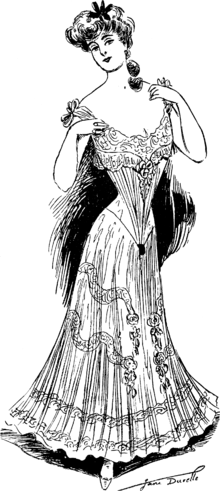
...tight lacing is fashionable again. One of the most exclusive corsetieres in Oxford Street, who is the authority for the statement, said today:
"We are on the verge of another tiny-waist craze. The demand for the smaller sizes in corsets has doubled in the last six months. Eighteens are now in common demand and orders for seventeen-inch and sixteen-inch corsets have greatly increased in the last few weeks. Not a few of my clients are systematically training for the fashionable measurements.
"When the eventual size is decided upon, three pairs of corsets are made, one for ordinary wear, one for special occasions, and another for night wear. To take a typical case, a young lady was brought to me by her mother at the beginning of the year. The girl, who was 16 years old, was tall and already possessed of a well-developed figure. She had a waist that measured twenty inches. Her mother was desirous that it be reduced to sixteen inches.
"I provided three pairs of corsets of graduated sizes, and the young miss wore sixteen-inch corsets, laced close the week before last at the Buckingham Palace garden party. She and her mother were so delighted with the effect that the girl came to me a day or two later to be measured for a pair of fifteens for dress occasions."
School
In fashionable society, a girl was expected to have a suitably small waist. Girls' schools were preparation for society and some headmistresses treated that attainment as part of the girls' schooling. As the girl was not yet an adult, her opinion was not considered. A reader wrote to the editors of The Science of Health describing her experience.[27]
At the age of thirteen I was sent to a fashionable boarding school in the neighborhood of Montreal, and was quickly given to understand that the system embraced not only special mental accomplishments and attainments, but also figure-training; that I might, in a word, be made a fashionable young lady. Need I say that the first article of dress attended to was my stays; those that I wore upon entering were removed, and another pair, smaller in the waist, more strongly made and heavily boned, were substituted. These were not removed night or day, except twice a week for a few moments, for the purpose of bathing, and each morning they were drawn a little closer, so that a regular system of reduction of about one-half an inch a week, and later one-half an inch a month, was enforced; until the degree of tenuity, consonant with beauty in the principal's eyes, was attained. [...] After six months my waist, having been reduced from twenty-two to sixteen inches, was considered small enough and no further attempt was made at reduction.
I found that this enforced wearing of the corsets at this period of the girl's growth begets an unwholesome appetite for tightlacing. Before leaving I found myself as anxious as the others to have my stays drawn in.
The West Australian printed excerpts from the diary of a school girl describing how figure training was accomplished.[28]
January 17th, 1864.– Returned to school today. Miss T— is pleased that mother is satisfied with my figure.
January 29th.– This morning Madame L— came and fitted all the girls in our class with new corsets. I have been horribly uncomfortable in mine all day. Katie A- cried all last night at having to sleep in her stays. Fancy a girl of sixteen not having been made to do so long ago; .... Miss T— showed me mother’s letter, saying that she had seen Lady de W—’s daughter at a house ball, who danced beautifully, and created a great amount of admiration with her 14in waist. So Miss T— says that I am to be made the same size.
How I shall be able to eat and move about I can’t think; but Madge O—, who left last term, and who was that size, said you feel awfully smart, and, in fact rather a pleasant sensation when you get used to the pulling in.
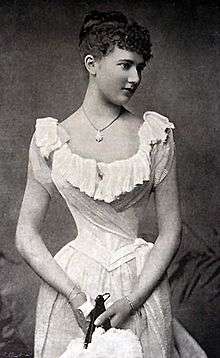
February 2nd.– The new Fräulein has come. She has a splendid figure; I wish mine were only as good. She told Agnes V— that she hardly had any need to lace at all, now; she was tightened when only twelve.
February 4th.– We were all given our “tapes” this morning; Fräulein seeing that they were put on properly, and explaining the marks to us. The 'tapes' are merely bands of stout webbing about 2in. wide, at one end of which is a stout buckle. In marking ink Fräulein has indicated inches, half-inches and quarter-inches; each of the latter representing, so she explained to us, a month’s reduction by her system. As I am already 17in., and expect to leave school in rather less than a year, I shall have, she says, to follow her directions implicitly if I intend to gratify mother with the size of waist she wishes me to have upon coming out. The new corset I am now wearing fits me beautifully, and although I cannot stoop much in it, or sit very comfortably, on account of the extra stiff whalebones, my figure is immensely improved, Miss T— tells me.
'This morning Fräulein and two of the girls laced me in fairly easily to 14½ in... After an hour or two, I got quite used to the sensation, which, as Fräulein told me it would be, is not very unpleasant, the pain which I scarcely knew how to bear for an hour or so having quite gone. My hips and waist feel rather numb, but that, Fräulein tells me, will pass off. At all events, I shall have the two dresses mother promised me at Christmas if I came back with a really small waist and a good figure.'
Three letters form a thread that illustrates the volleying back and forth.[29] The first was written by a mother, surprised that the school acted on its own.
I have been abroad for the last four years, during which I left my daughter at a large and fashionable boarding school near London; I sent for her home directly I arrived, and, having had no bad accounts of her health during my absence, I expected to see a fresh rosy girl of seventeen come bounding to welcome me. What, then, was my surprise to see a tall, pale young lady glide slowly in with measured gait and languidly embrace me?
When she had removed her mantle I understood at once what had been mainly instrumental in metamorphosing my merry romping girl to a pale fashionable belle. Her waist had, during the four years she had been at school, been reduced to such absurdly small dimension that I could easily have clasped it with my two hands. 'How could you be so foolish,' I exclaimed, 'as to sacrifice your health for the sake of a fashionable figure?'
'Please don’t blame me, mamma,' she replied; 'I assure you I would not have voluntarily submitted to the torture I have suffered for all the admiration in the world.'
She then told me how the most merciless system of tight-lacing was the rule of the establishment, and how she and her forty or fifty fellow-pupils had been daily imprisoned in vices of whalebone drawn tight by the muscular arms of sturdy waiting-maids, till the fashionable standard of tenuity was attained. The torture at first was, she declared, often intolerable; but all entreaties were vain, as no relaxation of the cruel laces was allowed during the day under any pretext except decided illness.
The daughter herself continued the account. Rather than deplore the practice, her remarkable conclusion was that tight lacing should be started at an early age.
In last month's number of your valuable Magazine you were kind enough to publish a letter from my mamma on the subject of tight-lacing, and as your correspondent ‘STAYLACE' says she is inclined to think the whole story made up for purpose, mamma has requested me to write and confirm what she stated in her letter.
.png)
It seems wonderful to me how your correspondent can lace so tightly and never feel any inconvenience. It may be, very likely, owing to her having begun very young. In my case I can only say that I suffered sometimes perfect torture from my stays, especially after dinner, not that I ate heartily, for that I found impossible, even if we had been allowed to do so by our schoolmistress, who considered it unladylike.
The great difference between your correspondent ‘STAYLACE' and myself seems to be, that she was encased in corsets at an early age, and thus became gradually accustomed to tight-lacing, while I did not wear them till I went to school, at fourteen, and I did not wear them voluntarily.
Of course, it is impossible to say whether I underwent greater pressure than she has; I think I must have done so, for my waist had grown large before it was subjected to the lacing, and had to be reduced to its present tenuity, whereas, if she began stays earlier, that would have prevented her figure from growing so large.
I quite admit that slender waists are beautiful – in fact, my own waist is much admired, and that I sometimes forget the pain I underwent in attaining it. I am also quite ready to confess that I am not in ill health, though I often feel languid and disinclined for walking out, nor do I think a girl whose constitution is sound would suffered any injury to her health from moderate lacing; but I must beg that you will allow me to declare that when stays are not worn till fourteen years of age, very tight lacing causes absolute torture for the first few months, and it was principally to deter ladies from subjecting their daughters to this pain, in similar cases, that mamma wrote to you.
I am sure any young lady who has (like myself) begun tight-lacing rather late, will corroborate what I have said, and I hope some will come forward and do so, now you kindly give the opportunity."
A woman signing herself as a schoolmistress defended the practice as an "elegant article of dress". Her solution agreed with that of the young lady, commencing the practice at an early age.
As regular subscriber to your valuable Magazine, I see you have invited your numerous readers to discuss the subject brought forward by a correspondent in Edinburgh, and as the principal of a large ladies' school in that city, I feel sure you will kindly allow me space to say a few words I reply to her letter.
In the first place it must be apparent that your correspondent committed a great mistake in placing her daughter at a fashionable school if she did not wish her to become a fashionable belle, or she should at least have given instructions that her daughter should not have her figure trained in what every one knows is the fashionable style. For my own part I have always paid particular attention to the figures of the young ladies entrusted to my care, and being fully convinced that if the general health is properly attended to, corsets are far from being the dreadfully hurtful things some people imagine, I have never hesitated to employ this most important and elegant article of dress, except in one case where the pupil was of a consumptive tendency, and I was specially requested not to allow her to dress at all tightly.
All my pupils enjoy good health, my great secret being regular exercise, a point which is almost always disregarded. It appears from your correspondent's letter that the young lady did not experience any inconvenience the first two years she was at the school, nor does her mother say her health was affected. She only complains that she is no longer a ‘romping girl.' Now, no young lady of eighteen who expects to move in fashionable society would wish to be thought a romping schoolgirl. With regard to no doubt caused by her not having been accustomed by degrees to a close-fitting dress before she went to the school.
I find that girls who have commenced the use of stays at an early age, and become gradually used to them, do not experience any uneasiness when they are worn tighter at fourteen or fifteen. There can be no doubt that a slender figure is as much admired as ever, and always will be so. The present fashion of short waists is admitted on all hands to be very ugly, and will soon go out. Those girls, then, who have not had their figures properly attended to while growing will be unable to reduce their waists when the fashion changes, whereas, by proper care now, they will be able to adopt the fashion of longer waists without any inconvenience. I trust you will allow us schoolmistresses fair play in this important matter, and insert this, or part of it, in your Magazine.
One young lady looked back upon the practice with affection.[30] Today, one might read these accounts with skepticism, but contemporary advertisements describe corsets as small as 15 inches.

I venture to trouble you with a few particulars on the subject of ‘tight-lacing,' having seen a letter in your March number inviting correspondence on the matter. I was placed at the age of fifteen at a fashionable school in London, and there it was the custom for the waists of the pupils to be reduced one inch per month until they were what the lady principal considered small enough. When I left school at seventeen, my waist measured only thirteen inches, it having been formerly twenty-three inches in circumference.
Every morning one of the maids used to come to assist us to dress, and a governess superintended, to see that our corsets were drawn as tight as possible. After the first few minutes every morning I felt no pain, and the only ill effects apparently were occasional headaches and loss of appetite. ...
Generally all the blame is laid by parents on the principal of the school, but it is often a subject of the greatest rivalry among the girls to see which can get the smallest waist, and often while servant was drawing in the waist of my friend to the utmost of her strength, the young lady, though being tightened till she had hardly breath to speak, would urge the maid to pull the stays yet closer, and tell her not to let the lace slip in the least.
That tight-lacing was enjoyable is a recurring theme. For example:[31]
I was delighted to read the sensible letters of "Staylace" and "SmallWaist" and I hope you will allow me to join your charming conversation.
I had an experience in tight-lacing that may be interesting. My education was finished in a boarding-school near London, Eng., and figure-training was strictly attended to. Soon after my arrival the principal examined me and decided as to the size to which my waist should be reduced. I was quickly encased in a pair of stays, filled with bones, and with an almost inflexible busk, and before many minutes were over I knew what tight lacing meant.
Each evening before going to bed, and each morning as soon as I got up, one of the under governesses drew the laces a little tighter, so that in a week my waist was reduced five inches. After that, I was only reduced half an inch a month, till, when I left, I measured just seventeen inches.
For the first month the pain from the continued compression was very severe, but nature soon accommodated itself to the pressure and I began to enjoy the sensation of tightness. I have continued tight-lacing ever since, and my health has in no way suffered and the charm of my figure is more than compensation for the amount of suffering I had to undergo.
I have not been without a pair of stays, excepting the few minutes I spend in the bath, for over seven years, so I think I can speak with some experience.
Yours, etc.,
A Tight Lacer
Others were proud of their training and saw it as the source of a fine accomplishment;[20]
I have only lately left a finishing school, where tight-lacing was almost compulsory. I can, owing no doubt to the gradual lacing tighter and tighter, now wear sixteen-inch corsets without any inconvenience.
However, other young ladies recalled the practice with little fondness.[32]
WASP WAIST CONTESTS, Curious Course of Training in Old Time Girls' Schools A letter recently unearthed from a trunk shows that in the sixties of the last century, principals of girls' schools thought they were fitting the girls for society by urging them to retain small waists. Accordingly, they offered prizes to the girls having the smallest waists. The girls were put through a course of training for reducing their waist measures. The conditions of the contest were that the corset should not be removed on retiring at night and that each pupil must be inspected every morning to make sure she had not loosened her corset. One girl who engaged in the contest afterward wrote of it:
"Some of us tried hard to be permitted to retire from the contest, but we were rebuked for stultifying ourselves and accurse of making fools of our principals. On the following morning, the undergoverness, with her maid, came as usual to superintend the toilets, and after satisfying herself that each lace was drawn in to the utmost, she fastened it in a knot at the top and, passing the ends through a piece of card, placed her own seal on them, so that any attempt to loosen the corset during the night might be infallibly detected in the morning."
Marriage
There are many articles admonishing girls to abjure the custom of tight lacing and assuring them that no man they would want to marry had any interest in small waists. Typical of these is:[33]
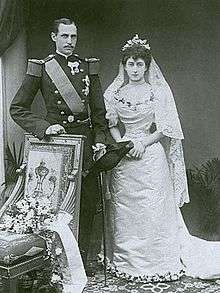
The fashion of light lacing obviously owes its origin to a desire on the part of the ladies to attract admiration. It is of little importance to point out that they are quite wrong in their calculations as to the effect, and that the other sex, so far from admiring a waist of extreme tenuity, shudder at it as something unnatural, and inconsistent with true beauty. Without regard to this fact, though it is in itself sufficient to settle the question, we would press upon the guilty parties, and all interested in their welfare, that tight lacing is a practice which cannot be long persisted in without the most disastrous consequences. It is painful to reflect that parents, so far from discouraging the practice, as often enforce it upon their children. We have heard of a young lady whose mother stood over her every morning, with the engine of torture in her hand, and notwithstanding many remonstrative tears, obliged her to submit to be laced so tightly as almost to stop the power of breathing.
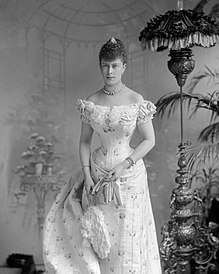
Another, entitled "The Absurdity of the Custom as Well as the Effect upon the Health of Slaves to the Fashion", begins:[34]
There would be no tight lacing if girls could be made to understand this simple fact: that men dread the thought of marrying a woman who is subject to fits of irritable temper, to headaches and other ailments we need not mention, all of which, everybody knows, are the direct and inevitable product of the compression of the waist.
Other articles suggested more dire consequences. A "Doctor Lewis" wrote [35]
A girl who has indulged in tight lacing should not marry. She may be a very devoted wife, yet her husband will secretly regret his marriage. Physicians of experience know what is meant, while thousands of husbands will not only know, but deeply feel the meaning of this hint.
Whatever the doctors might say, young ladies laced down in preparation for their wedding, as evidenced by contemporary photographs. Moreover, some women laced down after their marriage to please husbands who fancied the practice. One such wife wrote:[36]
I did not commence to lace tightly until I was married, nor should I have done so then had not my husband been so particularly fond of a small waist; but I was determined not to lose one atom of his affection for the sake of a little trouble. I could not bear to think of him liking any one else's figure better than mine, consequently, although my waist measured twenty – three inches, went and ordered a pair of stays, made very strong and filled with stiff bone, measuring only fourteen inches round the waist.
These, with the assistance of my maid, I put on, and managed the first day to lace my waist in to eighteen inches.
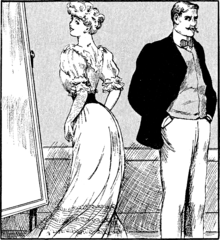
At night I slept in my corset without loosing the lace in the least. The next day my maid got my waist to seventeen inches, and so on, an inch smaller every day, until she got them to meet. I wore them regularly without ever taking them off, having them tightened afresh every day, as the laces might stretch a little.
They did not open in front, so that I could not undo them if I had wanted. For the first few days the pain was very great, but as soon as the stays were laced close, and I had worn them so for a few days, I began to care nothing about it, and in a month or so I would not have taken them off on any account, for I quite enjoyed the sensation, and when I let my husband see me with a dress to fit I was amply repaid for my trouble; and although I am now grown older, and the fresh bloom of youth is gone from my cheek, still my figure remains the same, which is a charm age will not rob me of. I have never had cause to regret the step I took.
A ladies maid recounted a similar situation:[37]
I hope you will pardon this letter, but reading the Hon. Mrs. B’s article on tight lacing, I thought one from a lady's maid might interest you, as we see a great deal of this sort of thing. I am living with a young married lady at present, who is most particular about her figure and appearance, and her husband is always talking to her about slim waists and lacing, as he admires it very much.
She is tall, about 5 ft. 8 in, and well made, so you can imagine what a business it is pulling her in to 17 in; but she has a splendid figure when she is dressed.

She always laced tight, but never below 19 in till she married a year ago. Her husband then persuaded and bothered her into reducing her size. People little think of what pain she is suffering when they admire her trim waist and tapering figure; but she is pretty, and has a very pale, good complexion, and white soft hands and pretty feet, so her female vanity supports her. At 9 o'clock I lace her, after her bath, and a housemaid helps me to squeeze her waist well in. As I tighten the lace she looks very white, and her lips often twitch as we pull her in. She never lunches, and does not walk very much. At night she wears a softer stay with a 19 in waist, as she says it is more painful to allow her figure to expand completely, and then lace it up again, than to keep it always about the same size.
A husband who fancied the practice wrote:[38]
When I married my wife she did not wear stays, but I soon induced her to improve her figure and before long, she had a nineteen-inch waist instead of one measuring nearly twenty-six inches, and though it is many years since then, she still retains a charming figure. At the age of seven, my girls were each placed in corsets and they are growing up with small waists that I can nearly span. Putting girls into corsets at a tender age before the figure is formed saves them from the pain induced by lacing at a later period. But I quote the case of my wife to show that even with a girl is grown up she can obtain a good figure with a little pains.
Fashion establishments
Girls working in "fashion establishments", as they were then called, wore corsets to suit the dictates of their employers. Tiny waists were required of employees to sell the then current fashions, much as size zero models are frequently used in fashion shows today.[39]
The editor of "The Ladies Page" of The Western Mail wrote[40]
- In a large establishment in the West End of London the standard is 19 inches, and any assistant who does not reach those dimensions within six months of her engagement is discharged. The person in charge of the girls' figures at this shop gave as her experience that out of every 100 girls she found three could not lace at all, six laced with difficulty, eight eventually gave up, ten endured the bondage, seventy really enjoyed it, and three laced excessively. At the time of admission, out of a hundred girls, three had 24 in. waists, six had 23 in., 18 had 22 in., 45 had 21 in., and two had 19 in. At the end of six months, by "judicious lacing," whatever that may mean, the figures were – 21 in. two; 20 in. six; 19 in. seventy five; 18 in. eleven; 17 in four; 161⁄2 in. two.
Fashion establishments were much the same in Paris:[41]
- ... some five and a half years ago the following advertisement caught my eye in the “Wanted” columns of a high-class ladies’ newspaper, I at once answered it. It ran as follows: —
- 'WANTED, at once, a young lady, pretty, tall (good figure essential), as “model” in a showroom of a well-known Paris couturiere. A slight knowledge of French desirable. Apply, with full particulars as to height, etc., and recent photograph, etc.'
- It had become necessary, owing to the death of my father, for me to do what my relatives with whom I went to live called “something.” In reply to my letter I was asked to call at an hotel, and after an interview with the principal proprietor and his forewoman, who was a bright and clever Parisian, I was engaged at a very good salary.
- A little less than a week later saw me at my post. I soon found that I was to be treated very much in the light of a good-looking, animated automaton. I was told that, though my figure was superb, my waist—which, as it measured about 20in, I had considered reasonably small—was too large, and that consequently, ere I was fitted for the dresses which were to be supplied for my wear, I must visit Léoty and obtain a couple of corsets which would reduce my waist to a trifle less than 18in. This I did, the firm defraying the cost, and I must confess that, though the waist-forming process was not pleasant at first, I was not a little proud of what was referred to as my beautiful figure. Nearly all the hands in the various ateliers and showrooms tight-laced. One girl, a pretty American who was much admired by customers and their male escorts, measured less than 17in over her dress. Several were barely sixteen, and it was to this latter size that I was told I should ultimately be required to reduce myself. I very soon got accustomed to the tight-lacing, and became as anxious as my employers that I should possess a fine figure, which the beautifully, though plainly, made dresses with which X—et Cie. supplied me showed off to perfection.
- Within a year of my coming to Paris I possessed the 16in waist desired by my employers, and was admittedly the finest figure in the showroom, in which I was chief model. Amongst our clientele, which comprised many of the smartest, richest and most beautiful women in the French capital, and also many smart Americans, there were, many who openly envied me my good looks, and—from a fashionable point of view—superb figure.
The practice was described by a shopgirl:[42]
- When I first accepted my situation, my waist was twenty inches. My mistress informed me that I would have to lace for the benefit of her customers and that I also must agree to sleep in her house.
- When I was ready to retire on the first night, mistress came and took my corsets away, and next morning she brought me a pair which were only 18 inches. She made me put them on and said that she would lace them in herself. I did as she told me and I had to stand with the other girls employed in the establishment while she laced me in. I did not like it at first, standing in a row with my hair hanging down, waiting for the mistress to come and lace me in, but of course I soon got used to it as all the other girls had to do. I was never allowed to dress myself until the mistress had laced me in ...
- One morning, I was sent for and found that three other girls besides myself had been called. We learned that we were to wear 16 inch corsets. At first I rebelled, but the mistress coaxed me ... When night came, I was glad, for I though I would be able to take the corsets off. Judge of my dismay when the mistress informed me that I would have to sleep in these corsets. Next morning as we stood in line, she measured our waist and told us we would have to continue sleeping in these corsets. Once a week, she said that we could be allowed to take them off. At last the time came for us to take them off and what a relief that was. In a short time, however, they were put back on again and laced in smaller than ever. ... At last, though, I got so that the sixteen inch corset would lace up tight and I knew I was a successful model. ...
- Now I am proud of myself. Mistress has gotten me so that my waist is only fifteen inches. My corsets, too, are well laced together. Everybody admires my little waist ... I am not sorry that I am a model as after all I have gone through I am well looked after my mistress, and if she were to ask me to put on smaller corsets, I would do so.
Various writers condemned the practice, for example:[43]
- Now there is one practice which is painfully common among all classes, and that is the use of the "locked corset". This is practically a steel corset, with a waist varying from about 14in to 16in. Into this the growing girl is compressed by force, the corset is shut tight and secured by a lock, the key being kept by the mother or whoever is responsible for the proceeding.
- It may be observed here that it is the usual practice for the heads of "trying on" departments in large dress-making and mantle-making establishments to require all girls engaged in "trying on" to enter one of these corsets, which is locked, and the key kept by the head. In the case of the growing girl, the object is to prevent the waist from growing as the rest of the body develops, and the idea is really only worthy of Chinese cruelty.
- In the case of the shop girl, the object is to "preserve" the figure precisely at the exact amount of compression which is supposed to I show off ladies' garments to the best advantage. In any case, the girl is confined in this way by the middle, night and day. She has to sleep in her "little ease" if she can, and the torture is such that at first even the shopgirl, worn out with the fatigues of the day, can hardly sleep for the pain.
- Probably nothing can be done until all women are sufficiently sensible, to realize that there is no beauty in a wasp's waist, that the majority of men do not really care a bit about it, and that there is real danger in tight-lacing, but surely the dreadful events which have happened lately ought to do something to emancipate schoolgirls and debutantes from their perpetual imprisonment in locked corsets. Elder women who compress on their own account are responsible for their own folly, but something ought to be done to put an end to this form of girl-torture.
Another wrote:[44]
- Girls in the more fashionable London stores make the most amazing statements in reference to dress regulations. They are compelled to compress their waists to a wasp-line slimness to show off the "creations" to the best advantage.
- The girls are expected to be living fashion plates," says the editor of a London trade paper. "They must have all the elegance of willowy style and lissome, grace of figure, without which they are no good in the service.
- The editor above referred to a letter from a girl in one of the most fashionable stores, and she makes this alarming statement: "The girls are laced up till they are nearly cut in two. Locked corsets are used, the key being kept by the manageress, and the corsets being worn night and day."
- In reply to a letter of remonstrance, the firm stated that it had certain regulations in regard to dress and other matters, and that no girl ever objected in the least to tight lacing.
One such shop girl certainly had her objections:[45]
- It is only two months ago that my employer insisted upon my reducing my waist from 16in to 14in, on the ground that she must have a model to show the newest fashions on. How could I refuse? I know many girls who would lace their waist till they fainted to get a good situation. And so to please these ladies, I am locked day and night into a vise which hardly allows me to breathe.
The dress reform movement
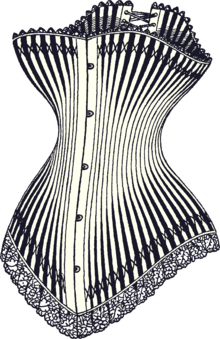
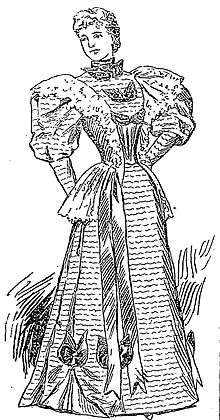
- See also: Dress reform movement
Advocates of dress reform deplored the impractical and restrictive fashions of the time. The bloomer dress was a mid-century attempt at rational clothing for women. It attracted considerable ridicule in the press and relatively few adopters. Other attempts at dress reform fared no better.
Various dress reformers turned to the printing press. In 1873, Elizabeth Stuart Phelps Ward wrote:[46]
Burn up the corsets! ... No, nor do you save the whalebones, you will never need whalebones again. Make a bonfire of the cruel steels that have lorded it over your thorax and abdomens for so many years and heave a sigh of relief, for your emancipation I assure you, from this moment has begun.
Louisa May Alcott devoted Chapter 18 ("Fashion and Physiology") of her 1875 young adult fiction, Eight Cousins, to advocating for dress reform in the form of the "freedom suit," which is described as being different from and more socially acceptable than bloomers. The young main character, Rose Campbell, is under the guardianship of her physician uncle Alec. However, her aunt Clara wishes Rose to dress appropriately to her position as an heiress, and one day gives her a fashionable outfit to try. Rose ultimately rejects it in favor of Alec's freedom suit, consisting of close-fitting pantaloons and shirt under a long-skirted petticoat and dress. Earlier in the novel, Rose had been wearing a tight belt to keep her waist small, which Alec insisted she stop doing for the sake of her health (Chapter 5, "A Belt and a Box"). When Clara tries to convince her to wear a corset, Alec is furious.
- He closed the door with a shrug, but before anyone could speak, his quick eye fell upon an object which caused him to frown, and demand in an indignant tone, "After all I have said, were you really going to tempt my girl with those abominable things?"
- "I thought we put them away when she wouldn't wear them," murmured Mrs. Clara, whisking a little pair of corsets out of sight with guilty haste. "I only brought them to try, for Rose is growing stout, and will have no figure if it is not attended to soon," she added, with an air of calm conviction that roused the Doctor still more, for this was one of his especial abominations.
- "Growing stout! Yes, thank Heaven, she is, and shall continue to do it, for Nature knows how to mold a woman better than any corset-maker, and I won't have her interfered with. My dear Clara, have you lost your senses that you can for a moment dream of putting a growing girl into an instrument of torture like this?" and with a sudden gesture he plucked forth the offending corsets from under the sofa cushion, and held them out with the expression one would wear on beholding the thumbscrews or the rack of ancient times.
- "Don't be absurd, Alec. There is no torture about it, for tight lacing is out of fashion, and we have nice, sensible things nowadays. Everyone wears them; even babies have stiffened waists to support their weak little backs," began Mrs. Clara, rushing to the defense of the pet delusion of most women.
- "I know it, and so the poor little souls have weak backs all their days, as their mothers had before them. It is vain to argue the matter, and I won't try, but I wish to state, once for all, that if I ever see a pair of corsets near Rose, I'll put them in the fire, and you may send the bill to me."
But dress reform had little mainstream impact. Fashion continued to emphasize the waist and, so long as it did, the corset continued to be regarded as an indispensable of dress. An unusually perceptive reformer described the situation in an address to the National Christian League in 1895. Her speech was reported in The New York Times:[47]
- WOMEN'S SLAVERY TO FASHION – She Admires Ideal Garments but will not Wear Them
- Mrs. Margaret Stanton Lawrence ... told of the artist who spent years in inventing a dress for woman that would be at once comfortable, convenient, and beautiful. Success crowned his efforts, but alas! who would invent the woman to wear this ideal garment! The dress was delightful, all women admitted, and filled every requirement, but – alas again for them! their husbands would not walk in the streets with the wearers of such a garb, their fashionable friends begged to be spared the visits of such unconventional creatures, and the clergymen in the churches asked that their congregations be not disturbed by thoughts of a woman's dress.
It seemed that change would be glacially slow at best. A year later, The New York Times wrote:[48]
- FOR THE LIBERATED WOMEN; THOSE VALIANT ONES WHO WILL GIVE UP THE BINDING CORSET. More and More Women Are Doffing Their Stays – But It Still Takes High Courage to Join Their Ranks.
- The receipt of several letters asking The Times to give some designs suitable for making up gowns to be worn without corsets has suggested the article here presented. The leaven is working among women: Many have discarded them, many more, mothers, who feel that it is too late for them to change, are persuading their growing daughters to omit their adoption. ... Human nature is weak, very weak, when it comes to the question of personal appearance, and having for generations adopted the standard of a tapering waist as a mark of feminine beauty of figure, it is going to take character, perseverance, religion even to counteract this. ...
- "One of the most pathetic speeches that I have listened to in a long time", said a woman recently, "was that made by a friend to me the other day. We were discussing hygienic dress and the use of disuse of corsets. I remarked casually and tritely that it took a good deal of moral courage to give them up. 'Moral courage!' she repeated, 'it takes wrestling with the Lord. There is no plea I have made oftener of my Heavenly Father than that He would give me strength to persevere in this thing'".
End of the controversy
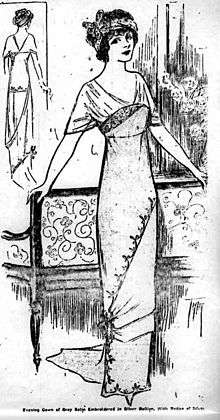
From 1908 to 1914, the fashionable narrow-hipped and narrow-skirted silhouette necessitated the lengthening of the corset at its lower edge. A new type of corset covered the thighs and changed the position of the hip, making the waist appear higher and wider.[49] The new fashion was considered uncomfortable, cumbersome, and furthermore required the use of strips of elastic fabric. The development of rubberized elastic materials in 1911 helped the girdle replace the corset. This was the huge turnaround for the history of waist trainer.
The corset controversy changed in the early 20th century when the world of fashion circled back to styles reminiscent of the Empire silhouette. Fashionable dress was fluid and soft, with flowing lines. What rational dress reform was unable to accomplish in decades of rhetoric, the wheel of changing fashion brought about almost overnight. The waist became unimportant and the waist-restricting corset lost its significance.
Paul Poiret was a leader in this movement. He replaced the corset with the hobble skirt,[50] which, while equally restrictive, was different and thus readily adopted in an era eager for change.[51] In his autobiography, Poiret wrote[52]
- It was in the name of Liberty that I proclaimed the fall of the corset and the adoption of the brassiere, which since then, has won the day. Yes, I freed the bust, but I shackled the legs.
The hobble skirt lasted but a few years, but its adoption marked the beginning of the end. Other designers such as Madeleine Vionnet, Mariano Fortuny, and Coco Chanel soon followed with simple comfortable fashions that freed the entire woman. With their adoption into mainstream fashion, the corset controversy receded into a historical curiosity.[53]
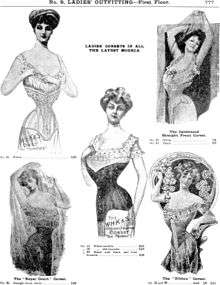
See also
- History of corsets
- Hourglass corset
- Tightlacing
- Victorian dress reform
- Victorian fashion
- Wasp waist
- Swedish Dress Reform Society
References
| Wikimedia Commons has media related to Corsets. |
- Jenkins, David (ed.), The Cambridge History of Western Textiles, Cambridge University Press, September 2003, p. 903
- Ewing, Elizabeth, Dress and Undress, A History of Women's Underwear, London 1978
- The Lancet, Volume 94, Issue 2400, 28 August 1869, "The Waist of the Period"
- Rousseau, Jean Jacques. "On Tight Lacing" The Lancet, 9, 1785, pp. 1202–3
- Wikimedia Commons, Category: Corset advertisements
- "The Corset Question". Chicago Tribune (14 November 1869)
- "The Pinch of Fashion", West Coast Times, (4 August 1884) p. 3
- "Corsets for Belles" The Saint Paul Daily Globe (2 February 1890)
- "The Slaves of Fashion" Chicago Tribune (5 September 1891)
- "Believes in Tight Lacing" Boston Globe (26 January 1893)
- "The Proof of the Pudding" Toronto Daily Mail (5 May 1883) p. 5
- "Women's Chats" The West Australian (5 November 1896), p. 3
- "Women Must All Tighten Up" Archived July 21, 2011, at the Wayback Machine Chicago Daily Tribune (29 December 1907)
- "The Waist of the Period" The Times, 2 September 1869
- Fashion In Deformity As Illustrated In The Customs Of Barbarous & Civilised Races By William Henry Flower, Ll.D. F.R.S. F.R.C.S. P.Z.S. Hunterian Professor Of Comparative Anatomy And Conservator Of The Museum Of The Royal College Of Surgeons Of England. London, Macmillan And Co. 1881. Available at https://archive.org/details/fashionindeform00flowgoog
- . Dictionary of National Biography (1st supplement). 1901.
- . Encyclopædia Britannica. 10 (11th ed.). 1911.
- Summers, Leigh, Bound to Please: A History of the Victorian Corset, Berg, 2003, chapter 3
- Wilder, Laura Ingalls, Little Town on the Prairie, (HarperCollins reprint 2004), p. 93
- "The Sin and Scandal of Tight Lacing" The Gentlewoman, 1883
- "The Victims of Vanity" The New York Times, (2 April 1893)
- "The Fashions for Summer" New York Times", (26 June 1881)
- Queen, London
- "Corsets and Such, A Devotee of the Corset" Boston Globe (8 January 1888)
- "Women's Kingdom" Toronto Daily Mail (7 April 1883) p. 5
- "Tiny Waist Craze Seizes on London; Revival of the Fashion of Tight Lacing". The New York Times (15 September 1907)
- "Voices of the People" The Science of Health, Vol. III – July to December 1873. p. 245
- "Figure Training at a Fashionable Boarding School", The West Australian (2 November 1895) p. 10.
- Lord, William Berry, The Corset and The Crinoline, Ward, Lock and Tyler, London, 1868, pp. 172-7
- Waugh, Norah. Corsets and Crinolines New York: Theater Arts Books, 1954, p. 141
- Toronto Daily Mail (21 April 1883) p. 5
- "Wasp Waist Contests" Amador Ledger (21 July 1911)
- "Deviations from Nature" Hobart Town Courier (10 February 1837)
- "Tight Lacing" Hartford Daily Courant (1 November 1884)
- "The Health of the American Woman" North American Review (1 December 1882)
- "Foolish Fashions" All the Year Round (27 June 1868)
- "Ladies Gossip" Otago Witness (14 November 1889)
- "Women's Kingdom, Reply to Indignant Father" Toronto Daily Mail (9 June 1883) p. 5
- "London Fashion Week refuses to ban 'size 0' models from catwalk" The Independent (26 January 2007)
- "The Ladies Page Western Mail (12 June 1896)
- "Experiences of a Paris Dressmakers Model" Star (24 October 1903) p. 3
- "English Corset Models" Chicago Daily Tribune (23 September 1908)
- "Ladies' Gossip" Otago Witness (2 May 1895) p. 46
- "Tight Lacing by Clerks in London" Chicago Daily Tribune (3 November 1907)
- "News and Notes" Evening Post (September 1899) p. 3
- Phelps, Elizabeth (1873). What to Wear. Boston: Osgood. p. 79.
What to Wear.
- "Women's Slavery to Fashion" The New York Times (23 February 1894)
- "For the Liberated Woman" The New York Times (20 May 1894)
- Shah, Veronica. "Omorfio : DIY Beauty Tips and Style Trends". omorfio.com. Retrieved December 16, 2016.
- "Waistless Gowns Are Again Exploited by Poiret" The New York Times (15 October 1911)
- Ewing, Elizabeth, Dress and Undress, A History of Women's Underwear, London 1978, p.113
- Poiret, Paul, My first fifty years, Gollancz, 1931, p. 73
- "Waist cincher". waistcincher.org. Retrieved August 23, 2015.

